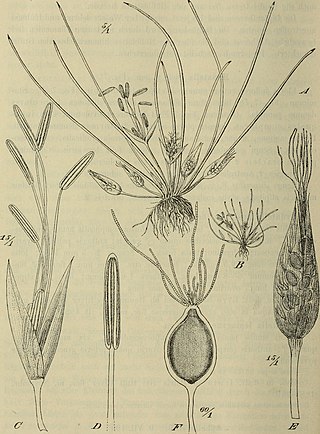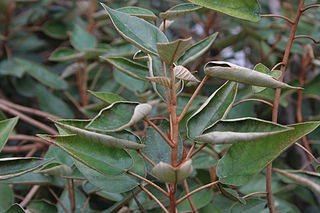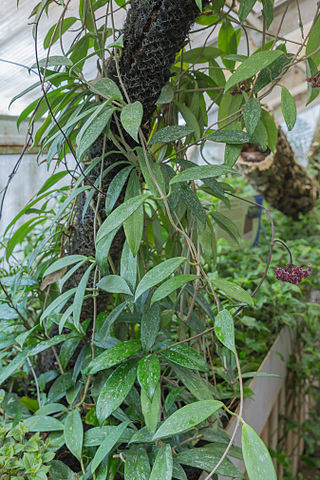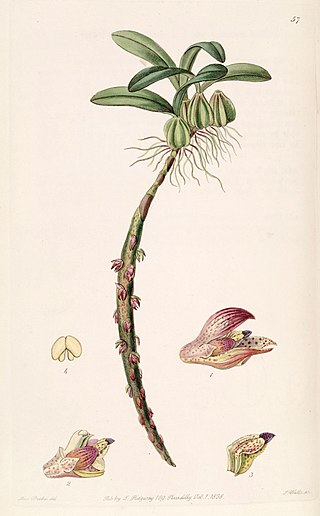
Physalis is a genus of approximately 75 to 90 flowering plants in the nightshade family (Solanaceae), which are native to the Americas and Australasia. At least 46 species are endemic to Mexico. Cultivated and weedy species have been introduced worldwide. A defining feature of Physalis is a large, papery husk derived from the calyx, which partly or fully encloses the fruit. Many species bear edible fruit, and some species are cultivated.

Isoetales, sometimes also written Isoëtales, is an order of plants in the class Lycopodiopsida.

Hydatellaceae are a family of small, aquatic flowering plants. The family consists of tiny, relatively simple plants occurring in Australasia and India. It was formerly considered to be related to the grasses and sedges, but has been reassigned to the order Nymphaeales as a result of DNA and morphological analyses showing that it represents one of the earliest groups to split off in flowering-plant phylogeny, rather than having a close relationship to monocots, which it bears a superficial resemblance to due to convergent evolution. The family includes only the genus Trithuria, which has at least 13 species, although species diversity in the family has probably been substantially underestimated.

The flowering plant genus Trochetiopsis consists of two extant and one extinct species endemic to the island of Saint Helena. They were formerly placed in the family Sterculiaceae, but this is included in the expanded Malvaceae in the APG and most subsequent systematics.

Cheirolepidiaceae is an extinct family of conifers. They first appeared in the Triassic, and were widespread during most of the Mesozoic era. They are united by the possession of a distinctive pollen type assigned to the form genus Classopollis. The name Frenelopsidaceae or "frenelopsids" has been used for a group of Cheirolepidiaceae with jointed stems, thick internode cuticles, sheathing leaf bases and reduced free leaf tips. The leaf morphology has been noted as being similar to that of halophyte Salicornia. Several members of the family appear to have been adapted for semi-arid and coastal settings, with a high tolerance of saline conditions. Cheirolepidiaceae disappeared from most regions of the world during the Cenomanian-Turonian stages of the Late Cretaceous, but reappeared in South America during the Maastrichtian, the final stage of the Cretaceous, increasing in abundance after the K-Pg extinction and being a prominent part of the regional flora during the Paleocene, before going extinct.

Pottiales is an order of mosses in the subclass Dicranidae.
Clowesia dodsoniana is an orchid of the genus Clowesia, found in the Mexican state of Michoacán. It lives at an altitude of 100 metres. It thrives in hot weather. It is pollinated by orchid bees.

Notocacteae is a tribe of cacti belonging to the subfamily Cactoideae. It is one of the oldest cactus lineages endemic to South America.
Elizabeth Anne Kellogg is an American botanist who now works mainly on grasses and cereals, both wild and cultivated. She earned a Ph.D. from Harvard University in 1983, and was professor of Botanical Studies at the University of Missouri - St. Louis from September 1998 to December 2013. Since 2013 she has been part of the Kellogg Lab at the Donald Danforth Plant Science Center in Missouri, where she is principal investigator In 2020 she was elected a member of the National Academy of Sciences.
Matthew David Barrett is a West Australian botanist. He has published some 70 botanical names. See also Taxa named by Matthew David Barrett. He worked at Kings Park and Botanic Garden and is currently employed by the University of Western Australia.

Coniopteris is an extinct genus of Mesozoic fern leaves. It was widespread over both hemispheres during the Jurassic and Early Cretaceous, with over 130 species having been described. While traditionally assumed to have been a member of Dicksoniaceae or a close relative of Thyrsopteris, a 2020 cladistic analysis found it to be a stem group of Polypodiales. Most species of Coniopteris probably had a herbaceous habit. Coniopteris laciniata had tufts of leaves sprouting from intervals of a thin, creeping rhizome. The genus is technically a junior synonym of the little used Polystichites, but was conserved by the ICZN in 2013. Some authors suggest a range of Early Jurassic-early Late Cretaceous for the genus, while others suggest a more expansive range spanning from the Middle Triassic to the Eocene.
Mentha japonica is a plant species in the genus Mentha, endemic to the islands of Hokkaido and Honshu, Japan. Initially described as Micromeria japonica by Friedrich Anton Wilhelm Miquel, it was first identified under its present name by Japanese botanist Tomitaro Makino in 1906. A relatively rare plant, it is classified by the Japanese Ministry of Environment as a Near Threatened species.

Hoya pubicalyx is a species of flowering plant in the genus Hoya native to the Philippines. Sometimes confused for Hoya carnosa, it has succulent, lanceolate foliage and grows in a vining habit epiphytically. Kept as a houseplant in temperate climates, it can be found in variegated forms in nurseries. The Philippine five-centavo coin of the New Generation Currency Series features the flowers of this plant.
Caetano Xavier dos Remedios Furtado was a botanist who specialized in palms. He worked at the Singapore botanical gardens. He described nearly 104 species of palms, worked on the African genus Hyphaene and on the family Araceae. The species Maxburretia furtadoana was named after him by John Dransfield in 1978. He was also involved in clarifying the terms "illegitimate" and "superfluous" names in taxonomic nomenclature. He also coined the word "basinym" which was modified as basionym.

Bulbophyllum sect. Bulbophyllaria is a section of the genus Bulbophyllum. It is one of six Bulbophyllum sections found in the Americas.
Bulbophyllum sect. Xiphizusa is a section of the genus Bulbophyllum. It is one of six Bulbophyllum sections found in the Americas.

Bulbophyllum sect. Micranthae is a section of the genus Bulbophyllum. It is one of six Bulbophyllum sections found in the Americas.

Bulbophyllum sect. Napelli is a section of the genus Bulbophyllum. It is one of six Bulbophyllum sections found in the Americas.
Asimitellaria amamiana is a species of flowering plant in the family Saxifragaceae that is endemic to Amami Ōshima in the Amami Islands of Kagoshima Prefecture, Japan.

Ozomelis is a small genus of flowering plants in the family Saxifragaceae, native to Alaska, western Canada and the western United States. It is probably sister to Heuchera.













